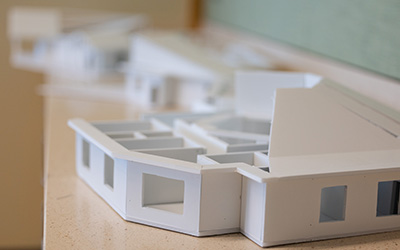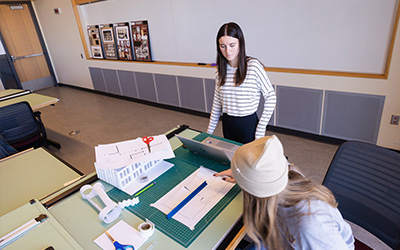Mapping out an interior design major
Whether you admire innovative room layouts, creative furniture choices or the way well-designed spaces make people feel, studying interior design could be the perfect path for you.
Discover what interior design looks like at Central Michigan University and apply today.
What is interior design?
 Interior design is more than simply decorating a room. At its core, it’s about creating functional, aesthetically pleasing and safe spaces tailored to a specific purpose and the people who use them. Interior designers must balance creativity, practicality and functionality to transform visions into reality.
Interior design is more than simply decorating a room. At its core, it’s about creating functional, aesthetically pleasing and safe spaces tailored to a specific purpose and the people who use them. Interior designers must balance creativity, practicality and functionality to transform visions into reality.
When designing a space, an interior designer considers:
- Layout and flow: How people will move through the space.
- Functionality: Ensuring the design suits the purpose, a quiet workspace vs. a social living space.
- Safety regulations: Meeting building codes and safety standards.
- Sustainability: Using eco-friendly materials and energy-efficient designs.
- Aesthetic appeal: Incorporating color, texture and style to produce the desired look and feel.
For example, designing a cozy coffee shop isn't just about choosing chairs and paint colors—it’s about creating an inviting space where customers feel relaxed and inspired to stay for a while. Good interior design tells a story while solving practical problems.
Architecture vs. interior design
While architecture and interior design are closely related, they serve distinct purposes in creating functional and beautiful spaces. Architecture focuses on the structural aspects of a building, such as the overall layout, foundation and external design.
Interior design is centered on the interior environment, crafting spaces that blend functionality with aesthetics. Interior designers work on elements such as furniture, color schemes, lighting and textures to achieve a specific atmosphere. Together, these disciplines collaborate to bring a cohesive vision to life, ensuring both the structure and interior speak to the needs and vision of the space's purpose.
Architecture students might design a small residential home, create blueprints for a community center or develop conceptual models for urban redevelopment.
Interior design students might redesign a living room with a specific theme, curate a functional office space, or create a complete interior plan for a boutique hotel. These tasks focus on selecting materials, creating mood boards and honing visual storytelling to enhance interior environments.
Why major or minor in interior design?
Here’s why studying interior design might be the right choice for you:
1. Unleash your creativity
If you've spent hours rearranging your bedroom furniture or sketching room layouts, you're already tapping into the creative side of interior design. Majoring in this field allows you to expand your skills, experiment with materials and explore innovative trends in shaping environments.
Interior design programs often feature hands-on projects that bring your ideas to life. Imagine designing a real living room or office space and seeing your plans turn into reality—complete with mood boards, floor plans and even virtual 3D renderings.
2. Learn practical solutions
Interior design isn't just art; it’s also about problem-solving. Imagine creating a tiny studio apartment that feels open and functional or developing a classroom that fosters better learning. A strong program will teach you how to meet challenges with innovative and functional solutions.
Beyond color theory and furniture placement, you’ll learn essential skills like:
- Space planning.
- Using industry-standard design software like AutoCAD or SketchUp.
- Working around budgeting constraints.
- Collaborating with clients or architects.
3. Booming career opportunities
The design industry is thriving. From corporate offices to cafes, hospitals to luxury homes, the demand for unique, functional spaces is higher than ever. People want environments that not only look incredible but also serve their purpose seamlessly.
An interior design degree sets you apart from casual hobbyists, equipping you with the skills to land exciting jobs with top firms or become a freelance designer.
4. A degree with flexibility
Majoring in interior design opens doors to many career paths. You could specialize in residential interiors, commercial spaces or even less traditional areas like event space design or product development. You don’t have to stick to one niche—expand and explore until you find your passion.
Interior design jobs and salaries
 Wondering what you can do with an interior design major? Here are some rewarding career options and their approximate annual salaries:
Wondering what you can do with an interior design major? Here are some rewarding career options and their approximate annual salaries:
1. Interior designer
Interior designers collaborate directly with clients, furniture suppliers, contractors and architects. Whether updating a home or planning a new hotel interior, this role brings immense diversity.
- What they do: Work with clients to design functional and attractive spaces in residential or commercial settings.
- Average salary: $60,340 per year.
2. Space planner
Space planners improve efficiency, functionality and aesthetics while ensuring compliance with safety and accessibility standards.
- What they do: Focus on how to effectively use space in offices, restaurants and similar venues by optimizing layouts and floor plans.
- Average salary: $56,000 per year.
3. Set designer
A passion for storytelling combined with design skills makes set design an exciting choice for aspiring creatives.
- What they do: Design environments for film, TV or theater productions.
- Average salary: $58,000 per year.
4. Exhibition designer
This job lets you tell compelling stories through spatial layouts and visuals, creating meaningful connections with audiences.
- What they do: Design displays and environments for museums, galleries and trade shows.
- Average salary: $57,000 per year.
5. Sustainable designer
With increasing awareness about climate change, sustainable design is a growing—and impactful—industry.
- What they do: Focus on creating eco-friendly designs using sustainable materials and energy-efficient solutions.
- Average salary: $70,000 per year.
6. Product designer
Why just design spaces when you can create unique items to fill them? Product designers innovate pieces that bring life to interiors.
- What they do: Design specific furniture, lighting or decorative products used in interiors.
- Average salary: $65,000 per year.
7. Freelance interior designer
Owning your own design business lets you work creatively on your own schedule, with unlimited earning potential if your designs are in demand.
- What they do: Run your own business, taking projects from clients who need your expertise in personalizing their homes or businesses.
- Average salary: Varies greatly (anywhere from $30,000 to over $150,000, depending on project size and frequency).
8. Interior architect
This career often involves working closely with construction managers, making it ideal if you enjoy combining architecture with interior design.
- What they do: Focuses on structural interior modifications, like redesigning layouts and integrating custom-built elements.
- Average salary: $74,000 per year.
Classes to explore if you’re interested in interior design
If you think you might be interested in interior design, you can start exploring the field in high school or earlier. Take art and design classes, learn design software, draw or create your own spaces and investigate colleges that have interior design programs.
Exploring interior design at Central Michigan University
In our interior design program, you'll learn how societies have used design throughout history and how to create modern spaces designed for the way we live today. You'll learn about lighting, textiles, architectural drawings and building codes — because your designs can't be seen if they can't be constructed.
Apply today to start designing your future at Central Michigan University.